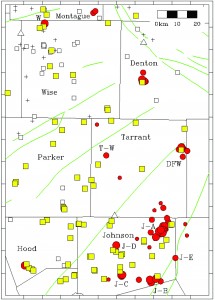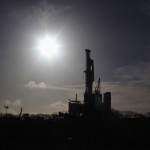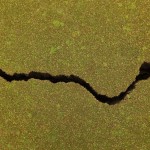How Fracking Disposal Wells Are Causing Earthquakes in Dallas-Fort Worth

Image courtesy of the University of Texas
This map Map shows earthquake epicenters examined in the study (red circles), injection wells (squares and + symbols) in use since October 2006, seismic monitoring stations (white triangles), and mapped faults (green lines).
If you live in the Barnett Shale around Dallas-Fort Worth, Texas, you may have noticed the ground has become a bit shakier in the last few years. And a new study by a Univeristy of Texas seismologist says that the wells used to dispose of fracking waste water are responsible. What’s more, there have been more than eight times as many earthquakes in the area than previously thought.
The rapid expanse of hydraulic fracturing, or “fracking,” has also led to an increase in the number of wells needed to dispose of the water used in the drilling process. (Fracking is a drilling process that uses a mixture of water, sand and chemicals to fracture rock formations deep underground for oil and gas.) Once that waste water comes back up the well, it has to be disposed of, so drillers inject it into deep wells underground, as deep as 13,000 feet below the surface in the Barnett Shale.
The problem, according to the new study by Dr. Cliff Frohlich, senior research scientist at the University’s Institute for Geophysics, is that some of those disposal wells around Dallas-Fort Worth are also on fault lines.
The seismologist uses the analogy of an air hockey table to describe what’s going on. If the air is turned off, the puck won’t move even if you push it. But when you pump in the air, it moves easily. With disposal wells sending fracking waste water deep underground, liquid and pressure are migrating into a “stuck” fault. “It wants to move but it can’t,” Frohlich tells StateImpact Texas. “Until you pump fluids in there and it slips.” Over 6 millions gallons of fracking waste water a month was pumped into each of the wells near the epicenters examined in the study.
(Update: Read about the Dec. 12 quake outside of Fort Worth here. )
So is there reason to be concerned about damage from these earthquakes? And what can drillers do to stop the tremors?
Disposal and injection wells are permitted and inspected by the Railroad Commission of Texas, which oversees oil and gas drilling in the state. The Commission would not accomodate a request for an interview today. They did say that staff would review the report.
But in a recent story in Fort Worth Weekly, the Railroad Commission of Texas claimed it has “no science or data at this time linking these minor seismic events to oilfield activities.” Yet the first study showing that link was released in early 2010, and another came out earlier this year. This is now the third study to find a link between disposal wells and induced earthquakes in the Barnett Shale, an area that had seen no seismic activity before disposal wells began operating.
And there have been several other scientific studies that have looked at disposal wells and earthquakes, all of them arriving at the same conclusion: there is a definitive link. “It is possible that some of these earthquakes have a natural origin,” Frohlich writes in the new report, “but it is implausible that all are natural.”

Photo courtesy of Dr. Frohlich
Dr. Cliff Frohlich of the University of Texas at Austin is researching the links between fracking and earthquakes.
Most of the earthquakes in the Barnett Shale occur in groups. In the new study, Frohlich found eight groups of quakes, all within two miles of disposal wells. Before this new report, there had been only two groups of earthquakes in the area linked to disposal wells in the area.
And those disposal wells are injecting at very high rates. “All the wells nearest to the earthquake groups reported maximum monthly injection rates exceeding 150,000 barrels (equivalent to 6.3 million gallons) of water per month since October 2006,” the study says. “If you’re a company, you might want to inject at lower volumes than that” to prevent quakes in the area, Frohlich says.
There were also other areas of high injection in the Barnett Shale, including Johnson County, that didn’t have earthquakes. “It might be that an injection can only trigger an earthquake if injected fluids reach and relieve friction on a nearby fault that is already ready to slip,” Frohlich says in a release accompanying the study. “That just isn’t the situation in many places.”
Most of these earthquakes are small, registering below 3.0 on the Richter scale. (Frohlich found dozens of earthquakes that were so small they hadn’t been detected by the National Earthquake Information Center.) But the study only looked at earthquakes between November 2009 and September 2011. Just over the past few months, there have been ten earthquakes registered in the area, one of them as high as 3.5 on the Richter scale.
Even at this lower level of intensity, the quakes are having an effect. Fort Worth Weekly recently told the story of the Rosalez family in Cleburne. One of the quakes popped a window out of its frame in their home and damaged their foundation. There are cracks in their walls now, some six inches long.
And there’s the open question of what kind of damage these induced quakes can do to drilling infrastructure. It’s plausible that the tremors could affect well integrity, Frohlich says. “In my business, you never say never. That said, most of the time these earthquakes are not right near the well. But it’s possible an earthquake could hurt a well,” he says, though he knows of no instances where that’s occurred.
And there’s a danger they could impact pipelines, which was covered in the Fort Worth Weekly piece:
““Pipeline operators are supposed to think of the possible risks when installing pipelines. I don’t think they considered earthquakes in Texas,” said Carl Weimer, executive director of the Pipeline Safety Trust, a nonprofit organization that advocates for safe fuel transportation.
Pipelines can be engineered to take into account stresses such as the ground movements caused by earthquakes and landslides. Weimer said he doubts Texas pipelines are engineered that way since Texas has historically not experienced earthquakes.”
But for Frohlich, the benefits of increased drilling outweigh the minor damage so far. “Clearly we need to worry about this,” he says. “But, you know, thunderstorms will sometimes drop a tree on your house. That doesn’t mean we can’t have trees. A magnitude 3.5 earthquake isn’t going to do damage except in a very tiny area.”
It’s also important to note that there a tens of thousands of injection and disposal wells in Texas, yet only a few dozen of them are suspected of inducing quakes. It’s also true that disposal and injection wells have been known to induce seismic activity since the 1960s. What’s happening now is that with the rise of fracking, there is a need for more disposal wells. And in areas where fracking waste water is disposed of near population areas, it’s going to be noticed more.
But there are ways to mitigate the problem. “With disposal wells, you have options,” Frohlich says. “You can truck it some place else, worst case you could even take it to some type of disposal plant.”
“It’s not entirely clear to me that you need to stop [the quakes],” Frohlich says. He likens the experience of feeling the smaller quakes to witnessing a moderate thunderstorm that might wake you up in the middle of the night with a boom. “It’s actually kind of fun,” he says.
A press release accompanying the new study notes that Frohlich has “no financial ties to the hydraulic fracturing industry” and that support came from the U.S. Geological Survey and Jackson School of Geosciences at the University of Texas at Austin.
The study will be published this week in the Proceedings of the National Academies of Sciences. Frohlich also plans to look at disposal wells and seismic activity in other drilling areas, like the Eagle Ford Shale in South Texas and the Bakken Shale in North Dakota. He also hopes to collaborate with the industry to evaluate faults near injection wells.




